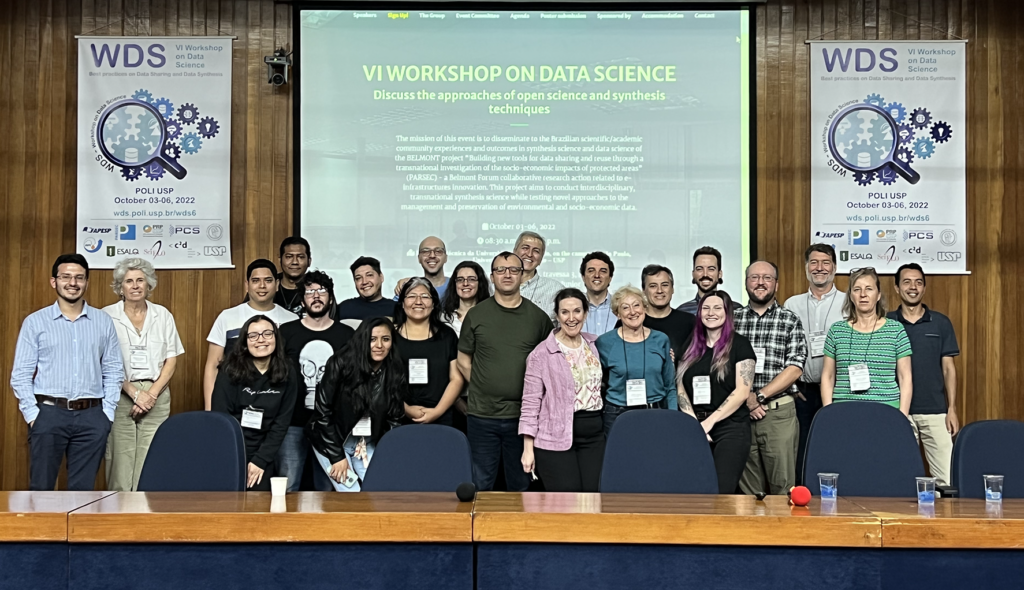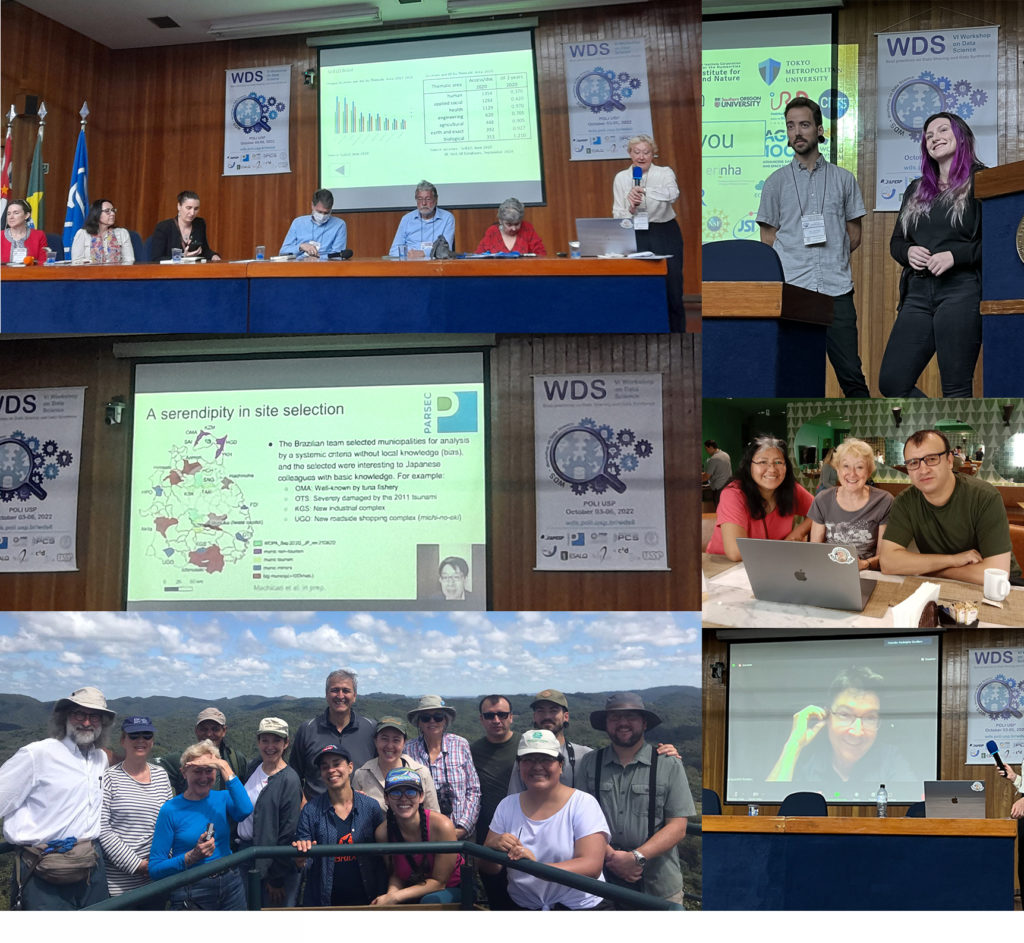Workshop 6 was held in conjunction with the 6th Data Science Workshop of the Escola Polytécnica of the University of São Paulo. We are very grateful to FAPESP for additional financial support for the meeting and Prof. Pedro Pizzigatti Correa and the Escola Polytécnica for their wonderful organisational support. We are most grateful for additional funding from IUGS and UNESCO to support the attendance of two early career scientists.

The workshop was open to the public from Day 1 to Day 4 (the ‘Symposium’). After that time, the PARSEC group worked on our various projects. This was a wonderful opportunity for engagement with the wider community.

Day 1 (3 October)
After the welcome and introductions, the meeting started with a round table on the topic ‘Challenges for Science-Driven e-Infrastructures Innovation (SEI) for the Enhancement of transnational, interdisciplinary, and transdisciplinary data use in environmental change research’. We were pleased to have Nicole Arbour (Executive Director, Belmont Forum), Claudia Bauzer Medeiros (FAPESP/Brazil), Lesley Wyborn (NCI and ANU), Abel L. Packer (SciELO), Bianca Amaro (Coordenação-Geral de Pesquisa e Manutenção de Produtos Consolidados – CGPC Instituto Brasileiro de Informação em Ciência e Tecnologia), Shelley Stall (AGU), Jean Ometto (Instituto Nacional de Pesquisas Espaciais – INPE), Katia Ferraz (ESALQ/USP) as presenters. This resulted in a fascinating discussion.
Following this round table each of the PARSEC leads presented updates:
- PARSEC Introduction, Alison Specht (University of Queensland)
- Synthesis Science, the PARSEC Approach, David Mouillot (Université de Montpellier) and Rodolphe Devillers (French National Institute of Research for Sustainable Development: IRD)
- Open Science, Open Data, the PARSEC Approach, Shelley Stall (Director for the American Geophysical Union’s Data Leadership Program).
The slides can be viewed here:
Specht, Alison, Devillers, Rodolphe, Mouillot, David, & Stall, Shelley. (2022). Introduction to the 6th PARSEC workshop and USP Data Science Workshop. VI Workshop on Data Science, Sao Paulo, Brazil. Zenodo. https://doi.org/10.5281/zenodo.7272616
The recording of the whole day is available here: https://youtu.be/xMyYyPwP-2Y
Day 2 (4 October)
Selected students from the Escola Politéca of USP presented their posters under the title ‘Data Science and Machine Learning as applied to the fields of ecology, environment and socioeconomics.’
The twelve posters are available for viewing on ESSOAr (Earth and Space Science Open Archive). Link here.
This session was followed by a suite of presentations on PARSEC Methodology and Study Cases
- PARSEC execution. Introduction to the application of the PARSEC synthesis model with case studies from East Africa. Ali Ben Abbes (Foundation for Research on Biodiversity-CESAB)
- Estimation of wealth index in Brazil: Pedro Luiz Pizzigatti Corrêa (Escola Politécnica da USP), Jeaneth Machicao and team
- Pandemic effects on tourism: Yasuhisa Kondo (Research Institute for Humanity and Nature, RIHN)
- Socio-economic assessment and PAs in Australia: Alison Specht (University of Queensland, TERN), Germàn Gonzalez (AURIN), Michael Rigby (AURIN)
- Mapping the socio-economic consequences of PAs in west coast USA: Jamie Trammell (Southern Oregon University) and Jeffrey Evans (The Nature Conservancy).
The slides for this topic are available here:
Ben Abbes, Ali, Correa, Pedro Pizzigatti, Machicao, Jeaneth, et al. (2022). PARSEC Scientific Results: methodology and use cases. PARSEC workshop Brazil 2022 plus USP Data Science Symposium #6, University of Sao Paulo, Sao Paulo, Brazil. https://doi.org/10.5281/zenodo.7278498
The recording of the whole day is available here: https://youtu.be/ZzxEFLvwEEo
Day 3 (5 October)
Hands on and tools training and demonstration. Data Strand members plus some invited experts engaged with the audience in promoting the dissemination of the techniques and tools of the PARSEC project.
- How to prepare a DDOMP: Shelley Stall (American Geophysical Union, AGU)
- Processes and pathways to disseminate science for wide and efficient reuse: Romain David (ERINHA, EOSC Life)
- The spectrum of data repositories: Margaret O’Brien (University of California)
- The value of controlled vocabularies for data understanding and re-use: Margaret O’Brien (University of California)
- Linking digital objects with DataCite and ORCID: Ana Heredia (ORCID)
- Introduction to international open science organizations: RDA and ESIP: Lesley Wyborn (Australian National University)
- Deep Learning for image analysis: Jeaneth Machicao (Escola Politécnica da USP) and Ali Ben Abbes (FRB-CESAB)
A second stage of this technical discussion was around the Reproducibility of PARSEC experiments: Workflow, Data Sets and Software Environment
- Cloud infrastructure and software tools: AWS, Data Map and Visualization tools: Pedro Luiz Pizzigatti Corrêa and Jeaneth Machicao (Escola Politécnica da USP).
- Dataset compatibility: (a) socio-economics and (b) protected areas (PARSEC teams).
- Reproducibility of Deep Learning Experiments: Jeaneth Machicao (University of Sao Paulo) and Ali ben Abbes (France)
The slides can be viewed here:
Stall, Shelley, David, Romain, O’Brien, Margaret, et al. (2022). Training and demonstration: PARSEC Data Strand members discuss the techniques and tools used in the PARSEC project. PARSEC Workshop 6 and USP Data Science Symposium, University of Sao Paulo, Sao Paulo, Brazil. Zenodo. https://doi.org/10.5281/zenodo.7259970
The recording of the day is available here: https://youtu.be/i-4bMJTMv0A
Day 4 (6 October)
Collaboration with other FAPESP initiatives such as NEXUS and the USGS.
- NEXUS FAPESP project – Challenges and opportunities related with study of socioeconomic indicators in NEXUS area in Brazil – Jean Pierre Ometto (Instituto Nacional de Pesquisas Espaciais – INPE)
- Data center of Aerosol Research Measurement. Amazon carbon project. Giri Prakash (Oak Ridge National Laboratory – ORNL).
- United States Geological Survey, Data Management and Analysis of Protected Areas in the USA, Mike Frame (USGS).
- Round table and discussion
The recording of this session is available here: https://youtu.be/hTVQiRyG4_U
Closure of Symposium
The remainder of Day 4 and all of Day 5 was spent working on the various PARSEC projects. These included remote meetings with team members who could not be here in person.
The group then went to a Protected Area in Vale do Ribeira, where we met with PA staff. A real-life test of some of the work we have been doing may ensue!


